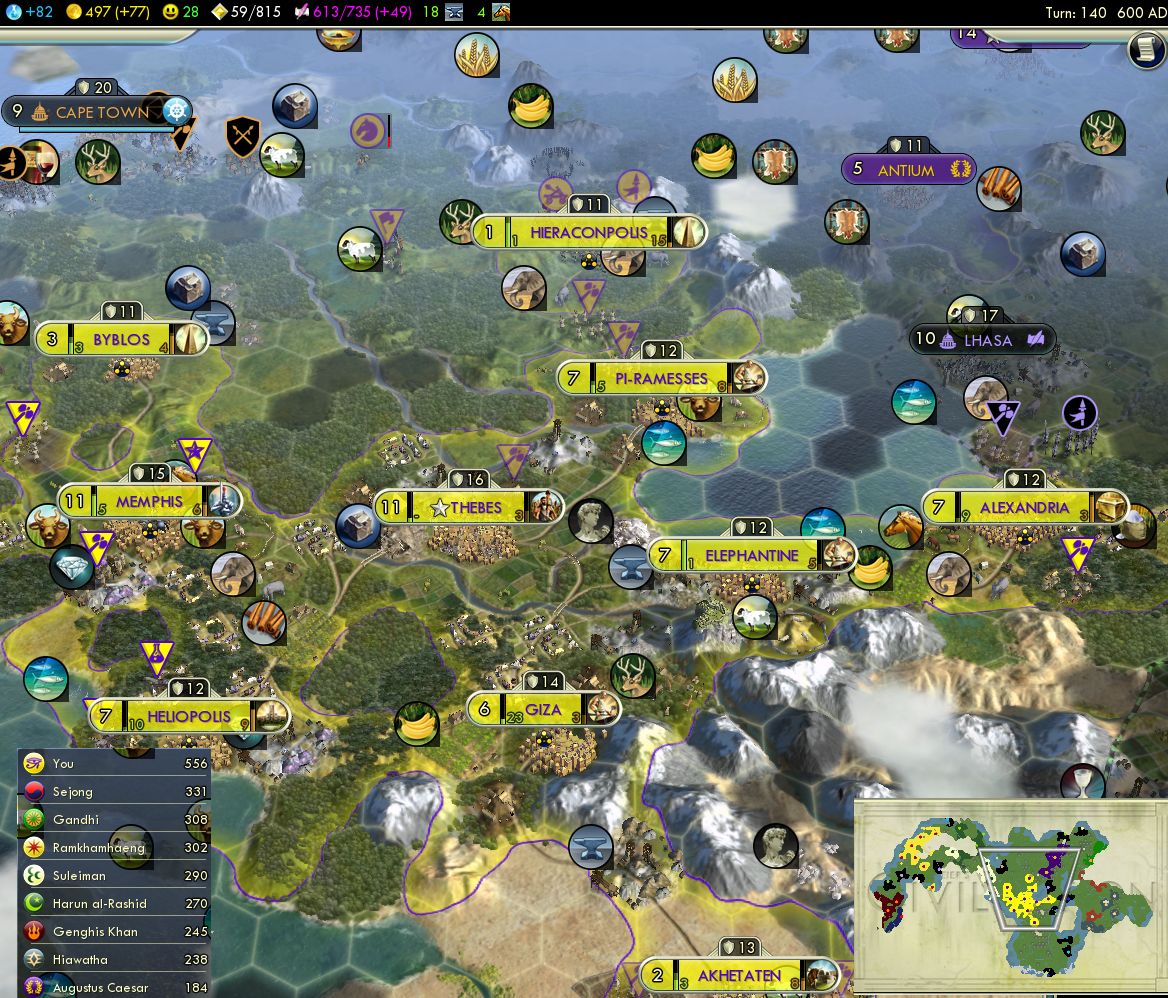
My expansion had slowed for a while, with Thebes busy on wonders not settlers. But presently my Egypt hit full stride on the ICS plan. Now I couldn't build enough settlers and workers to keep up with the happy cap! Each city went monument - burial tomb - colosseum (even before the granary), which with the Liberty and Piety policies, accounted for 4.6 happy per city before it would dip into the global happiness pool. And I added Circuses and Stone Works as appropriate of course. In fact, for a while my limiting factor on expanding was worker labor. Presently I realized that the +15% to land units bonus from a Forge works on workers. Giza built a forge and then churned out at least 10 workers in a row.
As for science, shouldn't Thebes be building things like a university? Not at all. That would be 160 hammers for 7 science. We could build a Settler instead for 67 base hammers, which would go reach 5 science very quickly with the maritime food.
Policies: I finished my initial plans, Liberty and Organized Religion, quite a bit sooner than I expected. All those monuments and temples kept culture flowing pretty well, even if the Burial Tomb is somehow worth one less than a regular temple. My only other target was the Order opener, still a long way away in the industrial era. So I delved into Patronage. I was already using lots of maritime CS, and that pointed me nicely towards a win condition. (And Greece was not on the map.)
Technology: I made my usual midgame tech beeline, bulbing Chemistry and Fertilizer for their passive boosts. Then to the techs for the Forbidden Palace and Taj Mahal.
The happiness bubble deflated after about ten more cities, but just then I completed the Forbidden Palace. This wonder is actually better than advertised thanks to how the math works out. A 10% anger reduction is better than a 10% happy bonus. With the FP, you can have 100/90 = 111% as much population for the same happiness, actually more than the apparent value of 110%. Furthermore, the wonder is additive with the -5% anger from Meritocracy, which means you actually get 100/85 = 118% population per happy, not 115%. Anyway, here the wonder was good to add a whopping 20 happiness and keep me snowballing
No other screenshots here because nothing particularly interesting happened, just lots and lots and lots of expansion. 50 turns after the previous overview, now I need two entire screenfuls to show the whole thing.
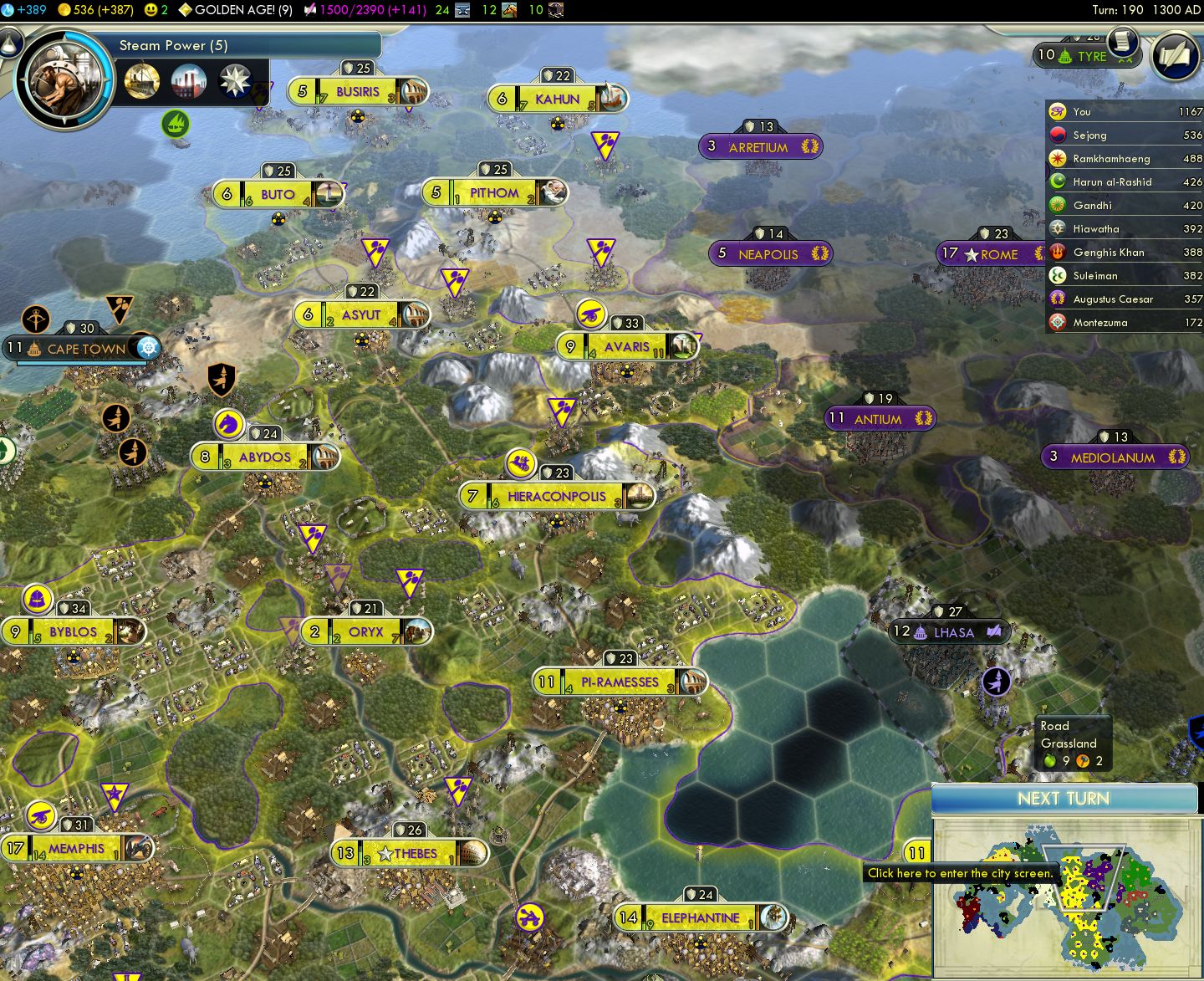
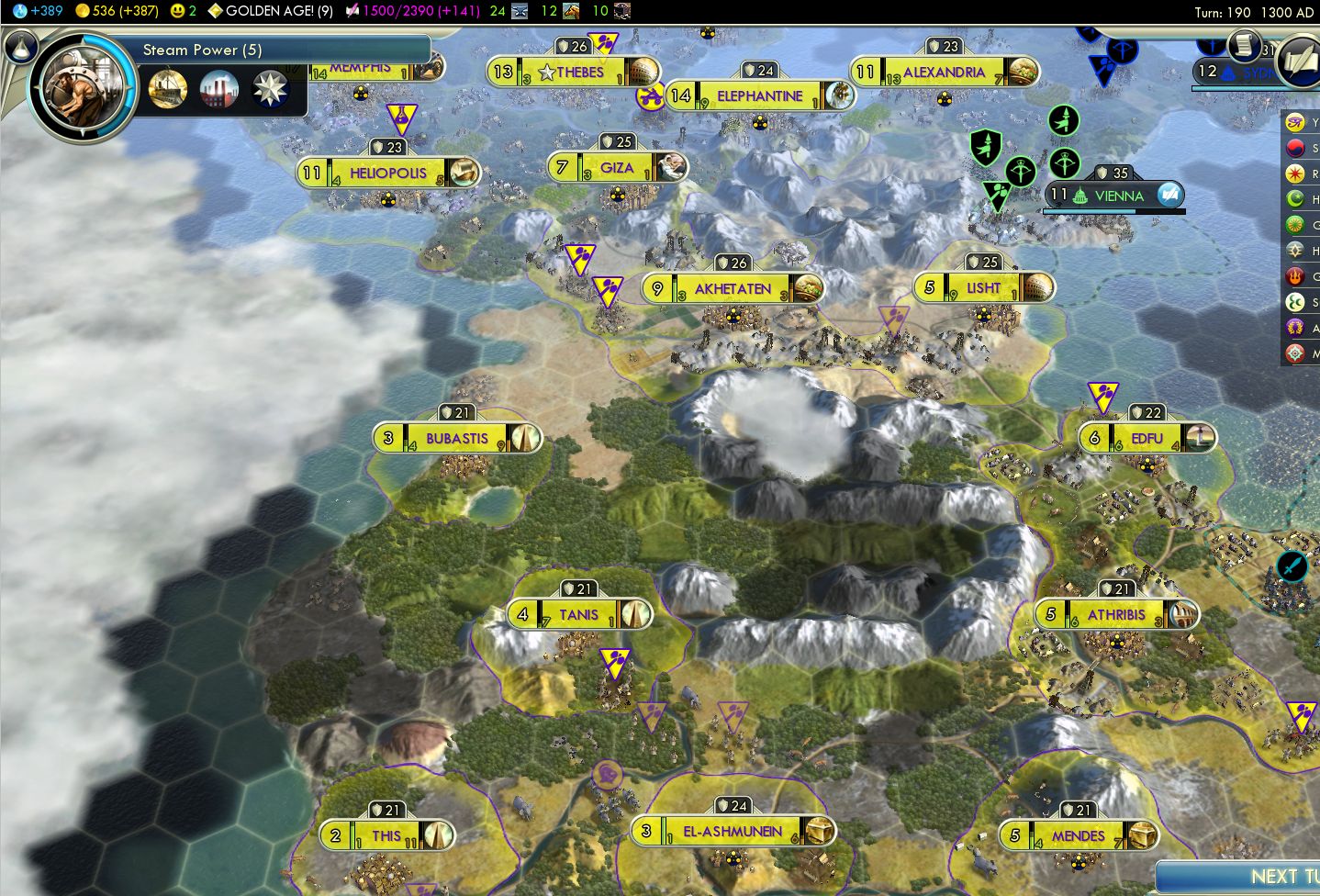
(By the way, I swear that that S-shaped mountain range in the south is the very incarnation of Trogdor!)
There's some ICS for you. 26 total. 16 cities added in 50 turns. All with happiness flowing freely thanks to the Egypt UB and the social policies. I was done expanding now, having put cities in every reachable place with decent land. I could have crammed in about five more cities on truly marginal terrain, ocean or tundra or the interior of that mountainy S. But that didn't seem productive, since the happiness bubble was depleting again.
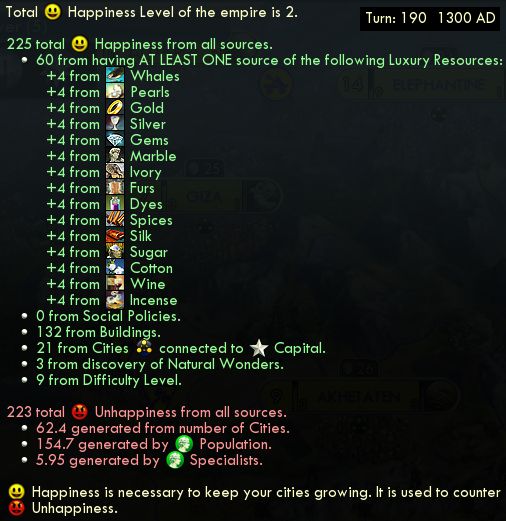
Order would arrive shortly after that and kickstart happiness again, although now it was needed to grow vertically instead of founding more bad cities. That's 182 population now and I'd reach about 300 by the end of the game.
In the gold department, I'd spent all of it on maritime city-states, eventually getting every one of the seven on the map as allies. Then with tech costs increasing through the Renaissance, now it was worthwhile to start signing Research Agreements. For a while, all my gold other than maritime CS went into RAs.
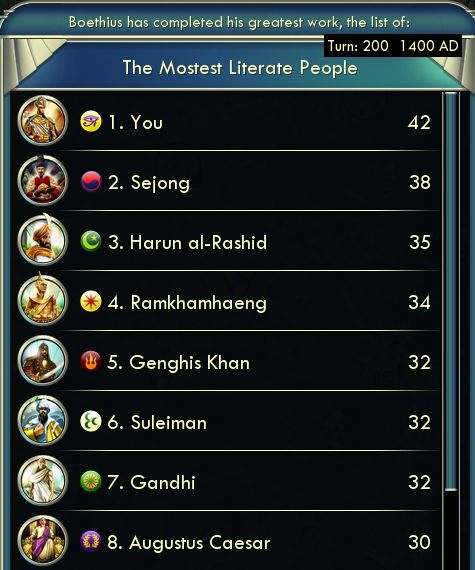
I moved through the Renaissance with a small tech lead, but that opened up quickly thanks to Research Agreements resolving every few turns. I continued to fill in more wonders: Big Ben, Sistine, Louvre, even Brandenburg Gate. The effects weren't that important, but they were easy to build with Egypt's bonus still applying. Some of them were wanted by city-states. But mostly each of the free Great People would turn into majorly profitable Golden Ages. (Incidentally, Big Ben gets the same mathy advantage as the Forbidden Palace. -15% cost isn't 15% extra hammers per gold, it's 100/85 = 118% of base.)

That Golden Age cash then went into buying every one of the 20 city-states on the map. This became rather absurd. Even with this galactically big empire, I'm still nailing social policies at a rate of 10 turns. So much for big empires can't play for culture. Thanks, culture city-states!
And not much happened for the entire game, really. No further wars. I'd kept one city building updated military units (knights, then cannons, then artillery) which kept my soldier rating competitive. I birthed and kept one Engineer for the United Nations too of course. The entire game consisted of watching all my cities grow, micromanaging a whole pile of workers (about 30), each building the happy buildings then growth buildings then science buildings. Just had to make sure they all got their universities done to qualify for Oxford University.
Research Agreements blasted through most of the industrial age, with a few Great Scientists spawning and getting saved for the endgame. But my regular beaker income ran pretty high as well, surpassing 1500 beakers by the end. The tech order didn't much matter because I wasn't using any of the later techs; the young cities were still just building basic stuff like libraries and theaters. I went to the Eiffel Tower early but that was the only notable beeline.
My gold income kept running to ridiculous levels too, over 500 per turn! I already had every single city-state on the map bought. The only thing remaining to buy was buildings in Thebes to optimize the end-game. While Thebes was building a hilariously expensive Oxford University (905 hammers), I bought the research lab and factory to squeeze out extra specialists of each type, and a hydro plant for extra hammers towards the United Nations.
Happiness stayed stupidly high too: I got back to +60 happy by the end! I'd built almost all trading posts and mines, no farms, expecting that trying to grow cities would overrun the happy cap. That did not come to pass and I could have focused on farms more, although it made very little difference either way.
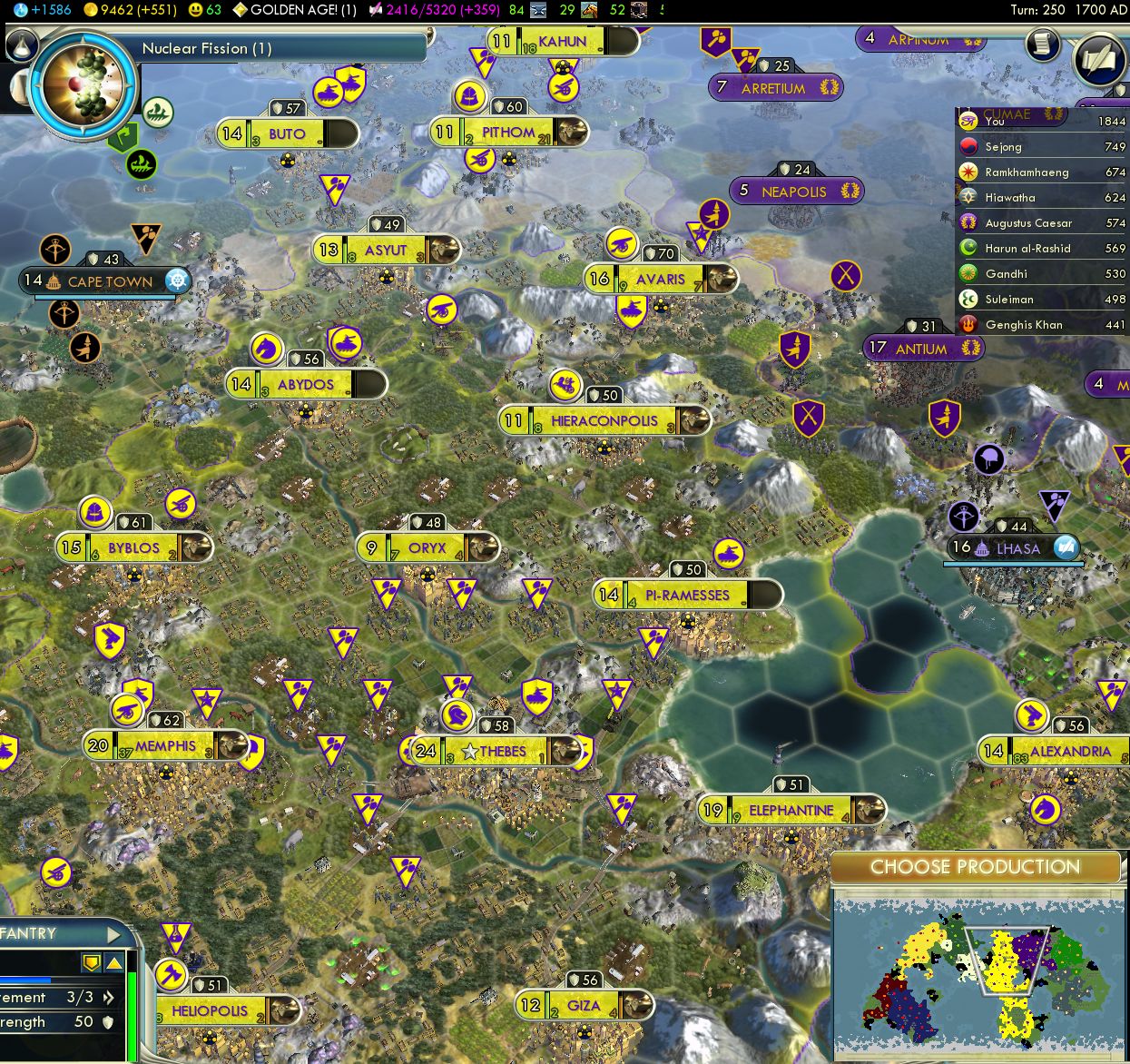
I won't dwell on the endgame optimization, just know that scientists and Oxford scored the last few techs towards Globalization, and a Great Engineer rushed most of the UN. 9 turns later, I scored a voting clean sweep for a very easy victory.

Diplomatic Victory at a very early 1700 AD. ICS lives indeed.
So I got my answer to what I was doing wrong in my previous Civ 5 games. Making buildings. My other games, especially Korea, saw me building up workshops and factories and harbors and driving myself into poverty. Wrong. Most buildings aren't worth it indeed.
Of course, that's a big switch from Civ 4, where buildings are always to the good and later buildings are always to the better. In Civ 4, why is one size 15 city better than three size 5 cities? Because the latter needs three copies of each building for the same output. But in Civ 5, that flips around. The lower end buildings are vastly better than the higher end, especially those that directly add production rather than multiplying. Three workshops ALWAYS beat one factory in productivity. Three granaries always beat one hospital, two markets always beat one bank, two colosseums always beat one theater. So you WANT more cities, size and quality be damned, because you want more copies of the cheap buildings.
And the rest of Civ 5 seems designed to patch around the push towards ICS that Jon Shafer and co clearly didn't understand in attempting to make a "small and lean" game. Global happiness is your one significant obstacle against going for maximum city count, but that can be overcome with social policies. National wonders are supposed to be another, but you can just ignore the lack of a National Treasury by building a Settler that will go earn more than 8 gold.
The science buildings are an exception, because they do only multiply rather than add and therefore would be just as productive with fewer taller cities. (The library and public school look additive but are really multiplicative with city population.) But since science buildings are the lone exception, the ICS cities might as well just build them anyway since there's nothing else worthwhile after the basic cheap buildings. And the university does have additive functionality with the scientist slots, which you use because scientists are the only worthwhile type of specialists and GP.
I may close the books on my Civ 5 reporting here. I do have a few more games to play (gotta try Always War for one), but I'm not sure I'll have anything to say that hasn't already been said. I'm also not jumping on the Gods & Kings expansion right away, but that does seem to be where the Civ 5 community is heading, so anything I write from here on would already be superseded. But I've certainly gotten my $9.98 worth out of the game and I think my readers have gotten their money's worth from my reports. ![]()